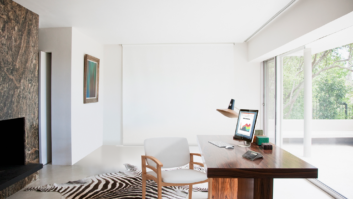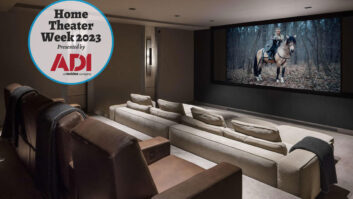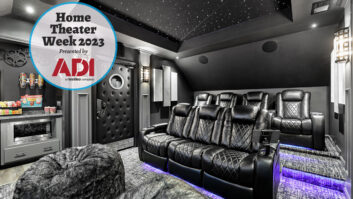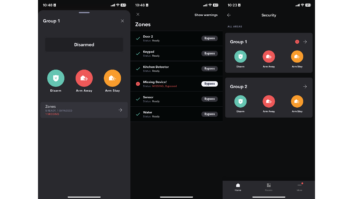

Whitlock’s Kirk Muffley has his office on a 40-foot SeaRay moored in Wilmington, NC, that he aptly christened “The Office.”Back when The Late Show with David Letterman was still new, the host used a running gag that presented directives sent to the show from “the home office,” which was located alternately in Sioux City, Omaha, or Oklahoma City. It was mildly funny, in part because it reminded us of a time when American business seemed uprightly Midwestern, perhaps even a bit benignly clueless but focused always on making America a better place for all through a combination of wholesome products and fair prices.
Fast forward to the Great Recession. The phrase “home office” has taken on a whole new meaning. Notwithstanding Yahoo CEO Marissa Mayer’s well-publicized rescission of the company’s workat- home policy last February, a 2012 U. S. Census Bureau report indicated that 13.4 million Americans now work out of their homes full time. Between 34.3 million and 36.6 million U.S. households now have active home offices, according to research firm IDC. Five years of a dodgy economy and millions of layoffs have compelled many to hunker down and start new businesses from their homes, and continued economic pressures have caused large corporations to ask or demand that some of their workers telecommute from their homes full or part time; a survey by project-management software company Wrike found that among 1,000 respondents, 83 percent worked from home at least part of the day.
That’s put a new focus on the home office, which is evolving from a board across two filing cabinets topped with a banker’s lamp and a flat-screen monitor into a full-fledged remote node of larger organizations or the central hub from which a new generation of entrepreneurs, willing and otherwise, are using to launch sophisticated businesses.
Teleconferencing Now a Core Technology
After the PC, the telephone and a broadband connection, the single most powerful tool in the most ambitious of home offices has become the video teleconferencing platform. While Cisco’s Umi residential teleconferencing product never got any real traction in the home, the idea of telepresence in the home office is catching on, thanks to a wave of free or virtually free platforms, from Skype to Apple’s FaceTime mobile feature. If those systems are whetting users’ appetites for a two-way AV experience, the growing tier of low-cost software companies offering SMB-type solutions is hoping that it inspires demand for the more sophisticated systems they’re offering.
“Let’s be honest, the biggest platform in use for the home office is Skype, because it’s free,” conceded Marty Hollander, SVP of market development at Vidyo, which offers multi-user conferencing for $30 per month. “And until [consumers] get comfortable and really appreciate what videoconferencing can do for them, free is good enough. You need to get comfortable with something new before you can decide to take the next step up. But once they do, we’re going to be there.”

Marty Hollander, Vidyo senior VP of market development and Tate Tran of Vidyo joined the author in a video teleconference interview for this article.In fact, users of Google’s Google+ Hangouts are already using Vidyo’s platform without realizing it. The company licenses its software to the search giant, and it’s what President Obama used when he took citizens’ questions after the State of the Union speech in February. In a sense, the free services are acting as a marketing tool for paid services such as Vidyo, Vsee, LifeSize, ooVoo, and others.
Cisco is a player in the home office space, of course, and its offerings reflect the company’s enterprise bent. Its TelePresence service uses the flagship EX 90 and EX 60 endpoints that can handle up to four users per session and are often configured with dual screens, one of which is used for documents and presentation materials. Cisco has extended its enterprise-level service to the mobile realm with Jabber, which can be used on premises or on the go via cloud computing as a web-based or subscription service, and an iPhone app that is expected later this year.
Kim Nguyen, a market manager for Cisco, said her company’s solutions tend to work as endpoints on a corporate network extended into the home and are generally provided and installed by the purchasing corporation, a fact reflected by the 55- and 65-inch screens’ $12,000 to $15,000 costs and 12 to 18-Mbps broadband requirements. Nevertheless, like all teleconferencing systems, their effectiveness is predicated to a significant extent on the look and ambience of the environment the users surround themselves with.

John M. Dlugosz, senior software engineer at Vsee, shows how documents can share a screen with live video.“Lighting is important, as is being aware of the noise levels around your desk,” she said, noting that videoconferencing is reaching the point where systems are left on all day, compelling users who do so to remember that comments and gestures are available for all to see, much like an open office door. “My phone hardly rings anymore; I’m just always connected at home to the office.”
That surrounding environment is where AV systems integrators can show value to home-office customers, many of whom can simply dial up Skype or other connection services themselves. “Sound– audio–is where integrators can really shine,” said John M. Dlugosz, senior software engineer at Vsee, who not only uses the service for telecommuting from his home office in Sunnyvale, CA, but also uses a 60-inch LCD in his living room for group conferencing. “Installers should impress on [clients] the need for audio and sell them that solution as well,” he added. “The large screen and webcam is something anybody could just pick up at the local big-box store, but my feeling is that conference audio is still an area where a pro can really make a difference.”
Dlugosz recommends using acoustical treatments on hard-surfaced and parallel walls in offices, and strongly suggests using a lapel microphone when teleconferencing solo on your end.
“You need a good speakerphone when you have a group on your end, and it’s even better if you can use several speakerphones along the length of a table, but when it’s just you, a lavalier keeps the sound very consistent,” he said. “Just make sure you wear it on the front of your shirt so that when you turn you head you don’t lose volume.”
Groups of users in the same locations can also use lavalieres, but he recommends the use of some kind of audio mixer for that. One other tip is for the featured speaker in any teleconference to use a handheld, wireless karaoke-type of microphone, which Dlugosz said acts as “a talking stick–it directs attention to the speaker and it improves the directionality of the sound,” he says, particularly useful when multiple remote locations are connected. Dlugosz has yet to see, but would like to, some kind of metering device, such as an LED meter in the corner of the screen, which offers the speaker some visible feedback that their voice is being picked up.
“The worst is when the CEO is talking but no one can hear him, but everyone’s too intimidated to say anything,” Dlugosz said.
Finally, he counseled, the quality of the teleconferencing experience is directly relatable to the level of components used. “You don’t have to spend $10,000 on a screen and audio, but you can spend $200 on a good microphone and keep your awareness of your environment in mind,” he said. “You’d be surprised at what you see behind someone you’re interviewing on the screen for a job.”
Some of the SMB services have come up with some useful features, such as Vidyo’s ability to move the main speaker at any given time to a more prominent place on the screen. The increasingly high resolution of video teleconferencing systems– Cisco’s handles 1080p easily and many expect 4K to make its mark on the market in the near future– puts a premium on environmental factors such as lighting. Vidyo’s Marty Hollander pointed to the Venetian blinds on the window facing him as he sat at his desk in his bedroom, a latticed screen modestly camouflaging up the bed behind him and his wife readying herself for her commute to work.
“Natural light is always the best, if you can access it,” he said, noting that he’ll adjust them for the time of day, something that an integrator can also include in an automation system. Hollander also keeps an incandescent light that he can add to illuminate his face to fill in any dark spots and for night work. “The last thing you want is the light coming from behind you; you’ll look like you’re in the witness protection program.”
Hollander says modern video codecs no longer demand solid-color backdrops but that as you move into HD, raw 1080p video requires a USB3- level camera to handle the additional compression capacity.
The High Life
Often, the level of technical sophistication that a home office can achieve depends on who is footing the bill. Mid-tier videoconferencing platforms can achieve remarkably good results, but when the office essentially acts as a node on a corporate enterprise, the big guns are needed.

The big players in video teleconferencing have scaled their offerings to accommodate the home office, such as this Cisco EX 60 endpoint.“Most home office clients are not using [Cisco] or Polycom codecs; they’re using Skype or another low-cost service,” observed Panos Anassisi, president of Audio Video Invasion on Long Island. “But when it comes to corporate environments, then the budgets go up.”
Anassisi said that he’s seen demand for advanced home offices increase in recent years, driven in part by the proliferation of more affordable codecs. At the same time, companies like Polycom and Cisco, which emphasize their more fully featured systems, have stepped up their marketing to alternate office environments. As a result, the range of costs for an office has significantly widened; Anassisi said he’s seen projects cost from between $5,000 and $7,000 on the low end to as much as $60,000 for a fullfeatured extension of an enterprise-level office. A recent project that saw a conference room installed above a three-car garage with dual 60-inch flatpanel displays for a Polycom system cost $55,000.
The cost of some components, such as the highend codecs and features like Polycom’s Eagle Eye, a $9,000 whiz-bang that enables a PTZ webcam to automatically find a face and track it as it moves around the room, bring the tabs for home offices up. But so do touches like custom millwork, which Panos Anassisi said tends to be an extension of a corporate aesthetic.

Smartphones and tablets have become the controllers of choice for the advanced home office, loaded with apps from control systems makers like this one from Savant.Nick Hearn, CEO of Hi Tech Solutions, says, “It’s normal for us to work with architects and even corporate interior decorators who are trying to achieve a unified look between corporate and home offices.” However, it’s not all corporate. With offices in Amarillo, Lubbock, and Midland, TX, he said his location in the booming oil and gas country also makes $50,000 home offices for entrepreneurial energy wildcatters. He points to a client who had an electrically charged smart-glass wall installed between his office and his garaged automobile collection, with a 60-inch smart-glass monitor embedded in it.
Clients may take a page out of Kirk Muffley’s book. The director of strategic alliances at nationally scaled integrator Whitlock has his office on a 40- foot SeaRay moored in Wilmington, NC. Speaking from the boat–aptly christened “The Office”– Muffley said that in addition to a higher level of installation, this type of home-office customer is also looking for ongoing managed services. To some extent, integrators are limited in their ability to access a corporate enterprise network, but other than that, these types of office owners expect their home automation systems to extend into the office suite. That includes the ability to open and close blinds and access points, adjust HVAC, monitor home security and other typical home control functions.
Savant’s Craig Spinner pointed to his company’s Savant Telephony systems as way to integrate home and office IP phones and use the same devices, such as tablets and smartphones, to control whiteboards and other presentation devices in the office.
Muffley noted that this kind of customer has a high expectation of quality of experience, and that has to apply to “both how the office interacts with the rest of his corporate experience and with the rest of his home.”
Some of the more common AV touches include surface-mounted speakers, usually in the ceiling, reducing clutter and improving intelligibility, particularly when used with echo-cancelling microphones. Panos Anassisi said that he often uses ceiling-mounted pendant microphones to allow others in the room to be heard clearly during teleconferences. Nick Hearn pointed to the more frequent use of wireless functionality, such as Wi-Fi and Bluetooth printers and even wireless electrical power, using WiTricity’s wireless energy transfer technology to cordlessly power laptops and displays.
The home office isn’t in Omaha anymore; it’s everywhere, and it’s becoming a more powerful tool in the corporate arsenal, even as it’s also driving–and benefiting from–deeper adoption of video teleconferencing. With American business still highly focused on increased productivity, expect the home office to remain a fixture of how we work.
Dan Daley is a freelance writer based in Nashville, TN.
Dolby Answers Call for Audio Conferencing Fix
Anyone who has ever engaged in a business conference call using voice over IP knows firsthand how impossible it is to naturally interact with the other participants. There are varying audio delays, cutting in to add conversational feedback is often confusing, and certainly awkward and cumbersome. A new technology from Dolby may finally solve this problem.
Dolby Voice audio conferencing technology is expected to come to market late this summer, delivered as software as a service (SaaS) by Dolby partner BT Conferencing. The subsidiary of British Telecom will offer the service as an add-on to its BT MeetMe service, as BT MeetMe with Dolby Voice.
Dolby Voice functions by creating a spatial audio scene where meeting participants can converse dynamically, the company says. The effect is to create an impression that sound is coming from unique points in space, as they do in reality, allowing participants to easily recognize who is speaking and understand what they’re saying. In addition, background noise is suppressed, so volume levels are consistent.
–Lindsey Adler







